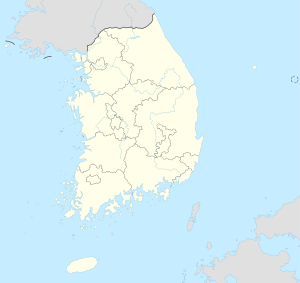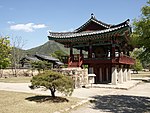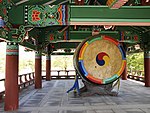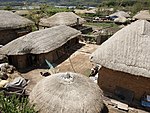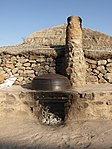Naganeupseong
| Naganeupseong | |||
|---|---|---|---|
| Korean alphabet : | 낙안읍 성 | ||
| Chinese characters : | 樂 安邑 城 | ||
| Revised Romanization : | Naganeupseong | ||
| McCune-Reischauer : | Nakanŭpsŏng | ||
| Basic data | |||
| Province : | Jeollanam-do | ||
| Coordinates : | 34 ° 54 ' N , 127 ° 20' E | ||
| Surface: | 0.14 km² | ||
| Residents: | 288 | ||
| Population density : | 2,057 inhabitants per km² | ||
| map | |||
|
|||
Naganeupseong ( Korean 낙안읍 성 ) is a historic village and city fortress from the Goryeo and Joseon times in southwestern South Korea .
geography
The village with its fortress is located in the northern part of an approximately 7.5 km by 3 km large plain fringed by mountains, in the rural community of Nagan-myeon ( 낙안면 ), about 15 km west-southwest of the city of Suncheon-si ( 순천시 ) in Jeollanam-do Province ( 전라남도 ). Gwangju ( 광주 ), the largest city in the province, is around 50 km to the northwest.
history
The village was founded during the Baekje Period (18 BC - 660 AD) and was the administrative center of during the Goryeo Period (918-1392) and the Joseon Dynasty (1392-1910) Nagan-eup ( 낙안읍 ), a district of Jeollanam-do Province.
Vulnerable to military attacks, General Kim Bin-gil 김빈 길 , who was born in Nagan , had a first earth fortress wall built around the village in 1397, in the sixth year of King Taejo's reign ( 태조 ). In 1424, in the sixth year of King Sejong's reign ( 세종 ), the wall was enlarged and replaced by a stone structure.
Fortification
Naganeupseong consists of a part of manor and administration buildings, which are located in the northeastern part of the complex and with an area of 18,000 pyeong (1 pyeong = 3.3 m 2 ) makes up about 1/3 of the total complex. The remainder of the southwestern part consists of the village complex, in which 950 people in 337 households once lived. Today the part is still inhabited by 288 residents in 90 households. The 450 m by 320 m large area is surrounded by a 1410 m long wall, which is accessible over its entire length. Today the fortress is accessible via three entrances, from the south-west and south-east via two gates, each with overbuilt buildings that were used for guarding purposes, and from the north-west via an open entrance flanked by buildings.
Buildings and village complex
The village consists of small, different parcels of traditional Hanok houses. The houses are made of wood, stone and clay and have the typical straw roofing for the settlement. The houses and courtyards are designed and equipped differently depending on the craft that is carried out by the residents. Some can be viewed by visitors by arrangement. A centrally located bakery, a cooking area, some ponds, a water wheel drive and a restaurant are further components of the village.
Manor and administration building
The manor and administration buildings, which are separate from the village in the northeast of the complex, are made entirely of wood and the roof is made of traditional Korean roof tiles. The substructure of the houses consists of stones on which the house rests. In addition to the houses for the administrators and civil servants, there is a central temple with a large barrel drum, which is traditionally played by Buddhist monks before their prayers. There is also a prison on the site, with equipment that was used to torture inmates.
National cultural asset
On June 14, 1983, the entire area of Naganeupseong was included in the national list of monuments and registered by the responsible Korean authority as a historical property under registration number 302. The Korean delegation to UNESCO had the Naganeupseong complex set the so-called tentative list on March 11, 2011 , thereby underlining its will to have the historic site nominated as a World Heritage Site.
Photo gallery
- Naganeupseong Historic Village and City Fortress
Hanok House of Administration
Hanok house
Hanok house
Hanok house
Web links
- Naganeupseong, Town Fortress and Village . In: World Heritage Convention - Tentative List . UNESCO, March 11, 2011,accessed November 12, 2017.
- Naganeupseong Folk Village 낙안읍 성 . In: This is Korea . Youtube, December 16, 2012,accessed on November 17, 2017(English, length of the video 2:00 minutes).
Individual evidence
- ↑ 전국 안내 지도 . 우성 지도 , Seoul 1999, ISBN 89-85762-10-9 , pp. 19 ( National Guide Map ).
- ↑ a b c Naganeupseong, Town Fortress and Village . In: World Heritage Convention - Tentative List . UNESCO, March 11, 2011, accessed November 12, 2017 .
- ^ Travel back 600 years at Naganeupseong Village, Fortress . In: KOREA.net . Global Communication and Contents Division , accessed November 12, 2017 .
- ↑ Naganeupseong Folk Village ( 낙안읍 성 ). Korea Tourism Organization , accessed November 12, 2017 .
- ↑ Coordinates and longitudes were partly made using Google Earth Pro version 7.3.0.3832 on November 12, 2017.
- ↑ a b Information board just behind the entrance on the southwest side of the village. As of March 28, 2011

